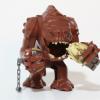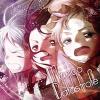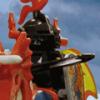Search the Community
Showing results for tags 'PRR'.
Found 14 results
-

[MOC] 1:48 Pennsylvania Railroad T1 4-4-4-4 Duplex v4 (Power Functions)
Commander Wolf posted a topic in LEGO Train Tech
Hello all, almost ten years ago I posted the first version of my 1:48 scale T1. This was one of my earliest scale models and it was perhaps not that great and/or perhaps limited by the parts of the era. The model underwent many changes over the years, but at least from an aesthetic standpoint it fundamentally stayed the same. Having designed, built, and operated a ton more trains since then, I finally decided to do a complete rebuild of the T1, and this latest version shares practically nothing with the earlier versions save for the overall profile. Most significantly I moved the drivetrain from the tender to the locomotive, after testing a similar setup in my PRR Q2 (behind). This is a much simpler and more performant setup, and unlike the Q2, the T1 has coupled bogies and can navigate R40 geometry. It it also still an almost entirely purist build save for the BBB #11 and #5 wheels. Anyways, see the video for more details and running shots, and have a nice day!- 6 replies
-
- prr
- streamlined
-
(and 2 more)
Tagged with:
-

[MOC] 1:48 Pennsylvania Railroad Q2 Duplex (PF / PU)
Commander Wolf posted a topic in LEGO Train Tech
Hello all, I have recently built a model that might actually deserve a post. This is a working, running (albeit only on R104 curves) 1:48 scale model of the Pennsylvania Railroad Q2 duplex. PF or PU motors power all five driving axles, and the design uses no third party parts besides #11 drivers. See the video for a more detailed description. -
Presenting my 1:48 scale LEGO model of the Pennsylvania Railroad X29 class boxcar. More photos can be found here. https://flic.kr/s/aHsmUx65ns Between 1924 and 1934, the Pennsylvania Railroad purchased or built close to 30,000 of the X29 class of box cars and an additional 5,000 of the auto car variant, the X28. The X29 was a 40ft long, 50-ton all-steel car design.The X29, which made up approximately one third of the PRR’s boxcar inventory for the time, became one of the most iconic Pennsylvania Railroad freight cars of the late steam and transition eras. These cars appeared in every corner of the US and Canada. Many of the cars remained in revenue service up through the 1960’s. The X-29 became a landmark design and copies were delivered to the Baltimore & Ohio, Wheeling & Lake Erie, Central New Jersey, Lehigh & New England, Boston & Maine and Maine Central as well as many more railroads. More prototype info can be found here. https://jbritton.pennsyrr.com/index.php/tpm/580-x29-series-box-car-information-for-modelers This model of the X29 features the Pennsy's 2D-F8 freight trucks, Creco doors, early door track and door stoop configuration, and KD brakes. I've been tinkering with a LEGO X29 off and on for years. This one I think is just about right. This is just part of my dive into this car as the X29 had quite a life span and came in many variations. It's probably one of the most important cars for any PRR steam era modeler. I will be building more of these in several flavors in the future. Thank you to Robert Douthwaite for inspiration on the Creco door design. His B&O version of this car can be seen below. Decal art work designed by me, and printed by OKBrickworks. Cale
- 4 replies
-
- prr
- pennsylvvania
-
(and 1 more)
Tagged with:
-
Hi all, wanted to share this MOC as I "teased" it many years ago but did not finish it until now. I started building the B1 in an effort to build the smallest possible 1:48 scale PF model, but ended up building the slightly smaller A6b, and then later on the even smaller EMD Model 40. Since then the B1 has been sitting in a folder on my computer gathering virtual dust. Last year someone inquired about the model and I decided to finish it once and for all, and this is the result: This is a pretty simple model just by virtue of the small size: the build is basically the same as that of the A6, just larger due to the larger scale size of the locomotive. It actually has a lot of volume compared to something like the Model 40, but the shape of LEGO motors and electronic components means that you can basically never fully utilize the 6-wide space in an 8-wide model. The part of the model that stumped me initially was connecting the massive side frames to the body. I had tried a couple times to find a solution over the years, but I finally cheated by cartooning the tanks on the sides of the locomotive with plates such that I could fit structural components behind them. The pantograph can also move up and down! Anyway, here is my video going into more detail about the model, as well as a Brickshelf gallery (when moderated). EDIT: Instructions for this model are now for sale on Rebrickable: https://rebrickable.com/mocs/MOC-48349/NonsenseWars/148-pennsylvania-railroad-b1-power-functions-9v
- 8 replies
-
- interiorsareoverrated
- power functions
-
(and 4 more)
Tagged with:
-
Finally getting around to posting some of these... I've been doing a bunch of small projects this year that I don't feel warranty their own thread, so this thread is going to be a home for said small projects. PRR MP54 Some years ago I built a set of PRR P54 coaches to go with my PRR T1. At the time I thought a fun future project would be to convert the cars to MP54 spec - the EMU version of the same car. Well, the future is now! Over the past few years I've been trying to build trains using all of various the LEGO motors, and the PF train motor was still on my hit list. I don't like the PF train motor that much because it doesn't have any low-speed torque, and the wheel spacing hasn't been correct for anything I've made so far. Recently I remembered about the MP54, and I thought it would be the perfect application - fast and doesn't need a lot of torque. Here is one of the original P54s as built: And here is the MP54 conversion: Of course the main difference is that there is a battery box, receiver, and motor in the MP54, but I've also updated the original model over the years, most noticeably by slowly collecting all the frames and glass. Other minor changes include the addition of headlights and a more vanilla bogie design to match the PF motor frames. Of course you want to see it go: I was really entertained by how fast it goes! Usually I prefer gearing down such that you get more torque and less speed, but watching this zip along is a fun change of pace. The pulling power isn't actually all that bad either, but as expected, you need to be going pretty fast before the PF train motor is generating any torque. One more interesting thing is that I'm actually using BBB wheels on the PF motor instead of the usual tyred wheels. I originally tried with the official wheels, but I due to the low torque I felt like it was really bogging down in the corners, so I tried the BBBs. This is a much smoother configuration, and it doesn't feel like I'm losing all that much grip. It can definitely pull at least the other two P54s and maybe another car or two. Okay, more to come soon. Hopefully.
- 12 replies
-
- pf
- power functions
-
(and 3 more)
Tagged with:
-
In 1917 Pennsylvania Railroad created the FF1 experimental electric locomotive. It was nicknamed Big Liz. PRR planned to electrify the Allegheny Mountains and have the FF1 haul freight through it. Big Liz was so strong that she would regularly ripped the couplers off the rolling stock of that era. Electrification didn't happen and Big Liz was scrapped in 1940. There was only one made and she was one of a kind. I followed LEGO 6 wide toy train designs and used Power Functions for motive power. The boxy boxcab design and 48 studs length provided ample room for AAA battery box, IR receiver, PF LED and M-motor. The prototype didn't go faster than 20.6 mph so I further geared down the M-motor output. PRR FF1 Big Liz by dr_spock_888, on Flickr The unique features of this locomotive are the jackshafts and side rods. I wanted to use 13L thin Technic liftarms for side rods. Since LEGO doesn't produce them in that size, I opted to make them with 123D Designer and Meshmixer. I sent the export file to my local public library for 3D printing. They came out to about 50 cents CAD each. The 3D printed pieces are useable but not LEGO plastic injection mold quality. It was challenging learning to use the software and DIY. I didn't yank out too much hair. Video of FF1 in action: Couple more pics on Brickshelf.
-
Built in 1952 by Pennsylvania Railroad, the "Queen Mary" was the world's largest freight car at the time. It was 121 feet long, weighed 250 tons and could carry 250 tons. Originally it was built as a depressed flatcar, class FD2. Later on in 1960 a "well" body was built for it to carry items which are narrow and tall like flywheel and rolling mill housings. The two bodies can be used interchangably on the same trucks depending which kind of load it is to carry. The Queen Mary was eventually retired in the 1990s during the Conrail era. The unit can be found today at the Altoona Railroaders Memorial Museum with the FD2 body. No one knows what became of the FW1 body. My MOC is the FW1 version of the Queen Mary flatcar. It follows LEGO 6 wide train style. It has 16 axles of standard LEGO bogies in groups of 4. It is 84 studs long. It can negiotiate LEGO R40 curves and switches. PRR FW1 Queen Mary Flatcar by dr_spock_888, on Flickr LEGO Power Miners giant wheel load: Serious overhang: Thanks for watching:
-
My little red caboose or cabin car in Pennsylvania Railroad terminology. Bobbers were simple wooden frame cabooses built in the 19th century. PRR made theirs with steel frames. That permitted their bobbers to be used in pushed service without being crushed. Their choice to use steel allowed their boobers to last well into the 20th century. PRR Bobber Caboose by dr_spock_888, on Flickr They were called bobbers because 2 axles gave a bobbing ride. I guess the modern ride equivalent would be of the U.K.'s Pacer railcars. Bobbers have a child's toyish feel to them. Maybe because many little children toy caboose designs are based off them.
-
My LEGO version of the Baldwin DR-12-8-1500/2 "Centipede". The Centipede was Baldwin Locomotive Work's first attempt at a road diesel locomotive. Its unique feature was 12 axles which made the locomotive looked like a centipede. Unfortunately, it was not reliable and none was saved from the scrap yard. My MOC is powered by LEGO Power Functions. It follows LEGO 6 wide train toy style. It is approx. 60 studs long. Baldwin DR-12-8-1500/2 Centipede by dr_spock_888, on Flickr View from back. The Centipede was original built for passenger service but engine failures left it relegated to freight service. Access to Power Functions AAA battery box. The batteries also adds weight on top of the PF Train motor. Access to engineer in cab for playability (and changing Infrared Receiver channel): It can negiotiate LEGO R40 curves and switches. Although it looks like it is going to take out anything next to the curves. I had to add a lot of articulation to the wheel arrangement. It would look best on the largest ME curved track. I think it is a suitable MOC for all those metal axles I have been making for bogies. There is something interesting about having lots of wheels on equipment.
- 10 replies
-
Shortly after jtlan's CNJ1000, I set out to make a small PF boxcab of my own! I think like many of the earliest diesel electric locomotives in the US, the A6 had its beginnings in the Kaufman Act of the 1920s, which banned steam locomotives from operating in New York City. PRR built three A6 class two-axled switchers (3905-3907), one of which was repowered and reclassified A6B (3907), all of which operated in various New York yards between the late 1920s and late 1950s. Here is a picture of the lone A6B with some B1s up for scrap in 1961: This projext actually started out as one of those B1s, but along the way we found engineering drawings for the A6/B, and I was able to cram the drivetrain I'd designed for the B1 into the smaller body of the A6B. The unit is 24 studs long between couplers and has about 400 parts. The power comes from an AAA battery pack driving the old 9v geared motor. Not surprisingly the most difficult part of this model was figuring out how to position the battery pack, the geared motor, and that darn PF receiver inside the scaled dimensions of the loco. There weren't *that* many potential combinations of fit, but I had to go through a couple. In the end it's actually pretty tight given that the face of the receiver is already at the same height as the top of the curved slopes that make up the sides of the roof. The transmission is as simple as I could possibly make it: just 8-tooth gears meshed into 24-tooth crowns. You could actually speed this up by using 12 and 20 tooth bevels, but I prefer to go slower and have more pulling power - I want to be able to use the most worn out AAAs floating around and still go somewhere. Consequently the loco is *really* slow, but I'll call that a feature. Otherwise, the build is pretty straightforward, but I did try to make the top easily removable. My only real beef with this implementation is that the L drivers are slightly too big and the 1x1 tanks slightly too small. The receiption is also not amazing due to the positioning of the receiver, but it could be worse. There's a flap in the roof to access the power button. I have no idea what the big tank in the back is for. Someone enlighten me. More pics Bonus material #1: I tried my hand at "weathering" the unit by changing some of the brick colors, but I couldn't really get a combination with which I was happy: Bonus material #2: LDD of the B1 that I didn't finish. Pantographs are a pain. EDIT: Instructions now available for sale on Rebrickable: https://rebrickable.com/mocs/MOC-76470/NonsenseWars/148-pennsylvania-railroad-a6b-v2-powered-up/#details
- 12 replies
-
- switcher
- interiors are overrated
- (and 7 more)
-
New MOC! This is the first model of an electric locomotive I've built. The Pennsylvania Railroad used these odd-looking twin-unit electric locomotives starting in the 1910s. Each half of the locomotive was powered by a single large electric motor in the body, connected to the driving wheels via a jackshaft and side rods, resulting in an effective wheel arrangement of 4-4-0+0-4-4 (2'B+B2' in UIC notation). To me, the jackshaft-and-side-rods drive system is a key part of the DD1's appearance. Consequently, the first thing I did was to figure out how to replicate the mechanism as faithfully as possible within the width of the model. By SNOT-ing the sides of the locomotive, I was able to make the bodywork only 1 plate thick in places, allowing me to pass a technic half-beam behind them. As a side benefit, the studs on the side line up nicely with the rivet lines on the prototype. After figuring out the mechanicals, I designed the bodywork in LDD, then placed a whole bunch of BrickLink orders with Commander Wolf to acquire all the windows, 1x3 tiles, and the giant pile of brackets required for the SNOTwork. I actually finished the model a couple weeks ago, but the soggy weather and other commitments prevented me from taking photos until now. I also took some video: Brickshelf gallery Let me know what you think!
-
EDIT: See post 39 for the final pics. Hey all, I'm building some "matching" passenger cars for my PRR T1 and I wanted to get any thoughts before they're actually built. This is the first time I'm trying to build nice rolling stock! These are PRR P54 cars built in the early 20th century; they came in a variety of flavors, most commonly (I think), an MU version, many of which lasted into the 70s. I'm referencing models of variants built for the LIRR, which was owned by the PRR during the first half of the century. I had originally wanted to model corrugated lightweights, which I feel are more timeless and less distinctly American (so I can pair them with other locos), but I couldn't find any such cars that weren't 70+ feet long - too long in my opinion. While I say the cars are "matching" it's "only" in period and railroad... whether the T1s actually pulled these types of cars I'm not entirely sure. The actual cars are 65 feet long and 10 feet wide, which make the models 45 studs long and 8 wide at 16.5" per stud. There's about 700 parts per car. For now, these are purely LDD models, but I finally have parts on order for three(!) of them. One thing that really annoys me is that Lego doesn't have a good small, round window. I feel like there's been several occasions where I've wanted it and haven't gotten it. In most variants the outside windows are round. I thought these bogies did a good job of capturing the angled flanges inside the actual bogies, but my friend didn't like them too much. Currently the plan is to use BBB smalls, but I'm concerned that the rolling resistance of all three cars will be too high. I've been trying to design trucks with the stock wheelsets, but I haven't found anything I'm happy with. There are some greebles on the bottom. No interior though; interiors are overrated. EDIT: Instructions now available for sale on Rebrickable: https://rebrickable.com/mocs/MOC-81265/NonsenseWars/148-pennsylvania-railroad-p54-coach-v3/#details
- 53 replies
-
- pax
- interiors are overrated
-
(and 3 more)
Tagged with:
-
My PRR B1 has reproduced itself into a PRR Class BB1. When PRR bought the first batch of the units, they came in BB1 configuration. The units were semi-permanently joined together. Only later on in life did PRR separated them into single B1 units and ordered further units as B1. PRR Class BB1 by dr_spock_888, on Flickr As a BB1 model, there is room to add Power Functions. An XL-motor can replace the M-motor if more power is needed. I had to add tires to the drive wheels to give it more traction around curves. I find the 0-6-0 wheel configration fascinating in these electrics. YouTube video: More pics on my BrickShelf: http://www.brickshel...ry.cgi?f=539207
-
Full Gallery Pennsylvania Railroad T1 Duplex (4-4-4-4) Steam Engine #5544, one of the Sharks of the Pennsylvania Railroad. The Pennsylvania Railroad's 52 T1 class duplex-drive 4-4-4-4 steam locomotives, introduced in 1942 (2 prototypes) and 1945-1946 (50 production), were their last steam locomotives built and their most controversial. They were ambitious, technologically sophisticated, powerful, fast, and distinctively streamlined by Raymond Loewy. Sadly, however, the inevitable march of Dieselisation meant that every T1 was out of service by 1952 and the last was scrapped in 1956. None survived. This model is a near complete rebuild of my original version. While it may not be initially obvious, the locomotive is about 90% different parts, the tender was only slightly adjusted to prepare it for swap over to Power Functions. Changes include: XL drivers, SNOT boiler, added boiler length, new wheel arrangement and articulation, added details and an overall closer eye on matching the prototype. --Tony
- 13 replies
-
- steam engine
- duplex
-
(and 3 more)
Tagged with:




